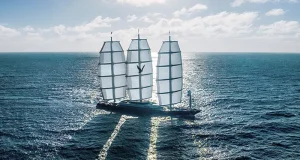When it comes to ocean exploration, some of the most exciting moments are when you see a species in mass. Witnessing a congregation typically involves far more luck than it does intricate planning. It’s a moment when you feel like all the cards have aligned and your wildest dreams are coming true. And when it comes to seeing epic megafauna in the wild, unaided by human intervention, I can think of no better place than Baja California Sur, Mexico.
For those unfamiliar with this fascinating region, Baja California Sur’s freediving offers a unique blend of beauty and challenge. The underwater world here is a spectacular showcase, featuring a dense population of sea lions, orcas, and the famed hammerhead schools that are hard to come by as their populations decline globally.
This unique ecosystem thrives thanks to the confluence of nutrient-rich waters from the Pacific Ocean and the Sea of Cortez. Baja California Sur, split from the mainland 2 million years ago, spans 1,250 km in length and 100 km in width, covering 74,000 square kilometers, about 4% of the entire country. In fact, the enormous length of this peninsula once led early European explorers to believe that California itself was actually an island! The region boasts two mountain ranges, with the tallest peak reaching 2,090 meters, adding to the dramatic and diverse landscape above and below the water.

However, the beauty of Baja California Sur comes with its own set of challenges. The region’s remoteness can make it difficult to access, along with lengthy travel times to reach prime diving spots. The strong currents and varying water temperatures also require divers to be well-prepared and experienced. Additionally, the impact of tourism and climate change poses ongoing threats to the delicate marine ecosystems. When it comes to tourism, there’s uncertified operators looking to make a quick buck, which can often result in overcrowding of dive sites, especially when sightings are too good to be true. To genuinely and sustainably appreciate and preserve this underwater paradise, it’s crucial to connect with local experts who understand and respect the area’s natural rhythms and challenges.
As our expedition team made our way to Baja California Sur, a hotspot on our trail was La Ventana—one of the best places in the world to witness the annual devil ray aggregation. Devil rays, also known as mobula rays, are large, migratory rays closely related to manta rays. They are recognizable by their triangular pectoral fins and horn-like cephalic fins. Known for their acrobatic leaps out of the water, these rays congregate in the warm, plankton-rich waters off the coast, particularly around La Ventana, where hundreds or even thousands gather to feed and mate.

These fascinating creatures are filter feeders, primarily consuming plankton, small fish, and crustaceans by swimming with their mouths open to filter food through specialized gill rakers. The aggregation is a breathtaking sight, with thousands of rays swimming in synchrony, creating a mesmerizing display. This phenomenon underscores the importance of conservation efforts, as devil rays face threats from overfishing, bycatch, and habitat loss. The annual aggregation not only offers a unique opportunity for divers and marine enthusiasts to witness an extraordinary event but also emphasizes the need to protect these majestic creatures and their environment.
For us, this was THE pinnacle of our diving expedition around the world, getting the chance to witness this natural phenomena and meeting the teams that work to safeguard it. And for us, there was no better team to work with than the Dive Ninja Expedition team to get a better look at what’s below the surface here. After reading about a marine biologist named Marta D. Palacios and her mobula ray research at Pelagios Kakunja, we were hooked and wanted to better understand even more about the aggregations of all aggregations.
Dive Ninja Expeditions, founded by Jay Clue, is a scuba and freediving operation committed to marine research and conservation. The core mission of Dive Ninjas is to bridge the gaps between tourism, science, and conservation, creating true ecotourism experiences. Their expeditions are designed around current research and conservation projects—like Marta’s work with rays—partnering with local scientists and advocates to offer citizen science-style trips. Those who are onboard not only learn about marine ecosystems but also participate in research activities that contribute to understanding and protecting these environments.
Dive Ninja Expeditions donates a significant portion of the proceeds from these trips to support ongoing research and conservation efforts. They also engage with sustainability consultants, marine scientists, and conservationists to continually improve their operations and minimize environmental impact. Dive Ninjas’ organizes site clean-ups, helps shark fishermen transition to careers in tourism, and supports sustainable diving, (in and out of ray season) as well as facilitates marine animal rescue efforts.
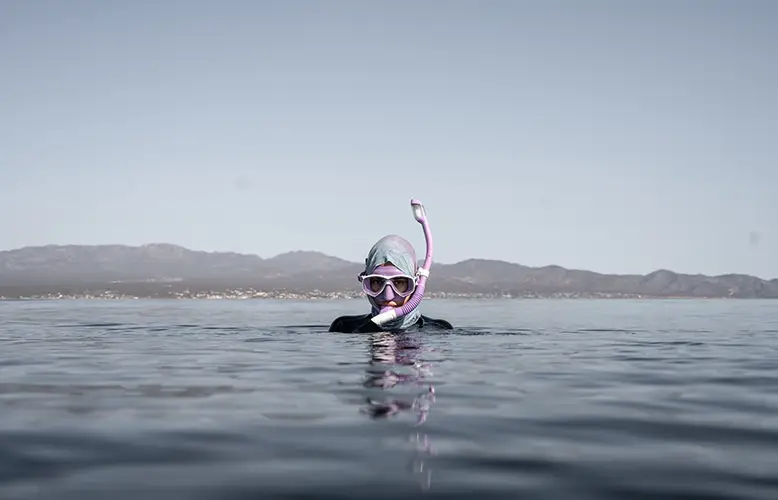
We pulled up to a villa in El Sargento, the neighbor of La Ventana, with quite literally nothing around us. Our car was dusted with blonde sand, and the water could not have been more still. The sun was blazing upon our arrival, but we had clearly arrived in remote paradise, shocked that this would be our newfound home. Out in front of us was “Jacques Cousteau Island,” also known as Isla Cerralvo to the locals. This stunning and otherworldly view was our backdrop, setting the stage for an unforgettable experience. We saw action out on the calm water, which we assumed could have been one of the five types of Mobulas – but we are here for the one and only Mobula Munkiana, also known as Munk’s pygmy devil rays.
The name “Munk” comes from Dr. Walter Munk, a pioneering oceanographer who made significant contributions to marine science and was instrumental in studying these rays. The “devil” part of their name refers to the horn-like cephalic fins on their heads, which resemble the horns of a devil. These cephalic fins help the rays funnel plankton and small fish into their mouths as they glide through the water, adding to their unique and somewhat mysterious appearance.
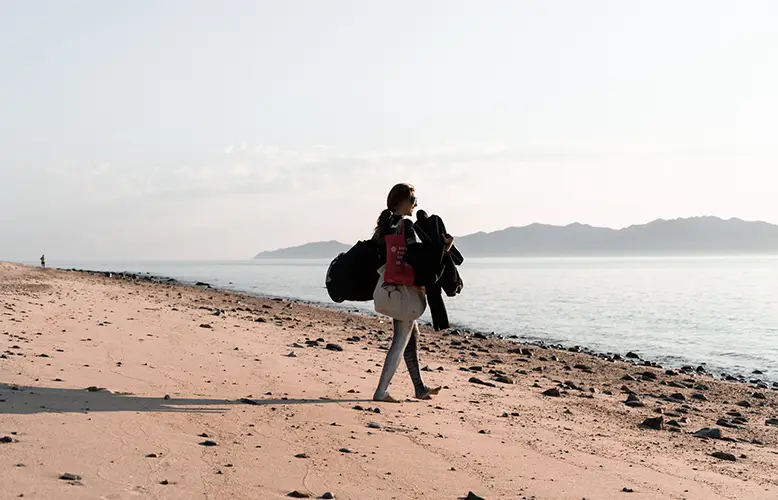
These rays span the coastal waters of the Eastern Pacific Ocean, from the Sea of Cortez (Mexico) to Peru. Known for forming massive aggregations of tens of thousands, these rays are particularly visible in the Sea of Cortez. Often breaching several meters out of the water, their behavior is thought to be linked to social dynamics. With an average length of 89-100 cm and a weight of up to 25 kg, they are vulnerable to gill nets and trawl fisheries due to their schooling habits. As the smallest and most social of the devil rays, they migrate and gather in Baja to mate and birth, creating the largest ray aggregation on earth from April to June each year.
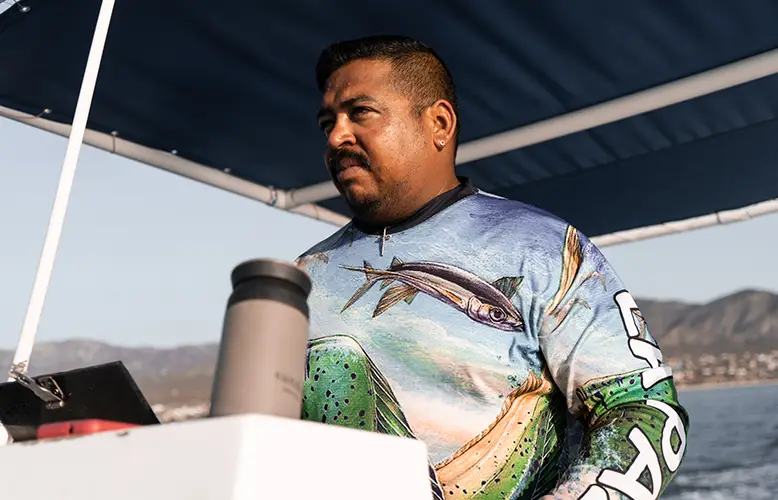
After eating a home-cooked meal from the Dive Ninja team, it was lights out, as we had an extremely early wakeup call the next morning to begin our ray search. During what would be a six-to-eight hour search, we aimed to spot orcas, dolphins, sharks, but most importantly, the rays. And what everyone on site had their fingers crossed for was what they called “the vortex.” The vortex is a rare mobula formation, occurring when the rays form a dynamic, spiraling formation, swimming in tight circles while feeding. This breathtaking spectacle creates an upward current, bringing plankton to the surface.
The next morning we were off on our quest. Because Dive Ninja heavily opposes chasing or harassing animals, focusing instead on conservation-minded practices while in the water, we were deeply briefed on diving protocol with the rays. Quiet entries, floating on the surface until the rays came to us, when they were shallow enough, we’d be able to duck dive, but only under the guidance of the Dive Ninja team. There were rules, and we were to follow as disturbing this moment would mean we were throwing off their mating rituals that are keeping these animals in the water not just now, but in the future.
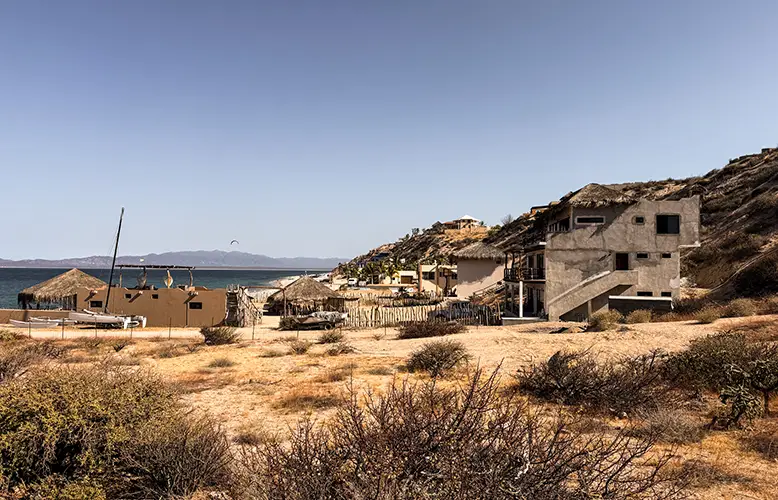
Within 10 minutes of searching, we were laying flat on the water surface observing our first congregation. After about 20 minutes, and after getting stung by countless jellyfish all the while, we were completely surrounded by rays in 1-2 meters of water. We all went down together on a single breath to observe them more closely, and to our surprise, with little motion on our part, they stayed with us, circling, feeding, breaching. It’s one thing to read about it, but it’s another thing to experience it. Seeing this peaceful, graceful and utterly flawless aggregation for ourselves was one of those indelible moments that will never leave our memories. For what was quite literally hours, we dove with them, watching, waiting, and duck diving when we could.
While we were out on the water, we heard rumors of orca whales in the area—one of the many reasons people are drawn to the waters of Baja throughout the year. The update blared over the boat’s radio, and what had been a peaceful, solitary experience suddenly turned chaotic. Boats appeared from every direction, racing to the site, each loaded with people sporting top-tier camera gear. We were told these were the “influencers” who have taken the region by storm.
A social media influencer is someone who has built a significant online following and uses their platform to impact the opinions, behaviors, or purchasing decisions of their audience through content creation and endorsements. There was one of the largest studies done in the USA on influencers in 2023 which reported “of the 103.7 million [USA-based] Instagram users, 10.2 million can be considered influencers. This means that 9.8% of all Instagram profiles in the USA have the potential to sway the purchasing decisions and behavior of their audience.” And many of these people want to highlight unrivaled experiences to share with their following. And with that, the rise of social media influencers has brought a new wave of attention to Baja, but not all of it is positive.
The demand for dramatic wildlife encounters has led to a surge of influencers using unregulated or illegal tour companies to capture their perfect shot. This practice not only harms the local industry but also sets unrealistic expectations for other tourists. Responsible tour operators, who prioritize the well-being of marine life, often face backlash from disappointed customers when they refuse to allow dangerous or invasive interactions with whale species, especially the orca, which is one of the most powerful marine creatures on earth. The pressure from social media is pushing the industry towards unsustainable practices, compromising the very environment that makes Baja so special.

If you’re planning to dive in Baja California Sur, timing and choice of partners are crucial. Being in the right place at the right time with knowledgeable and responsible operators can transform your adventure into an extraordinary experience—that not only benefits you, but also the ocean and its creatures as well. The unparalleled beauty and unique marine life of Baja California Sur promise unforgettable underwater moments when you connect with those who respect and understand this delicate ecosystem. Make wise choices to truly witness the magic of the underwater world in this remarkable region and you will surely have the time of your life, as long as those rays (and orcas) remain around.





